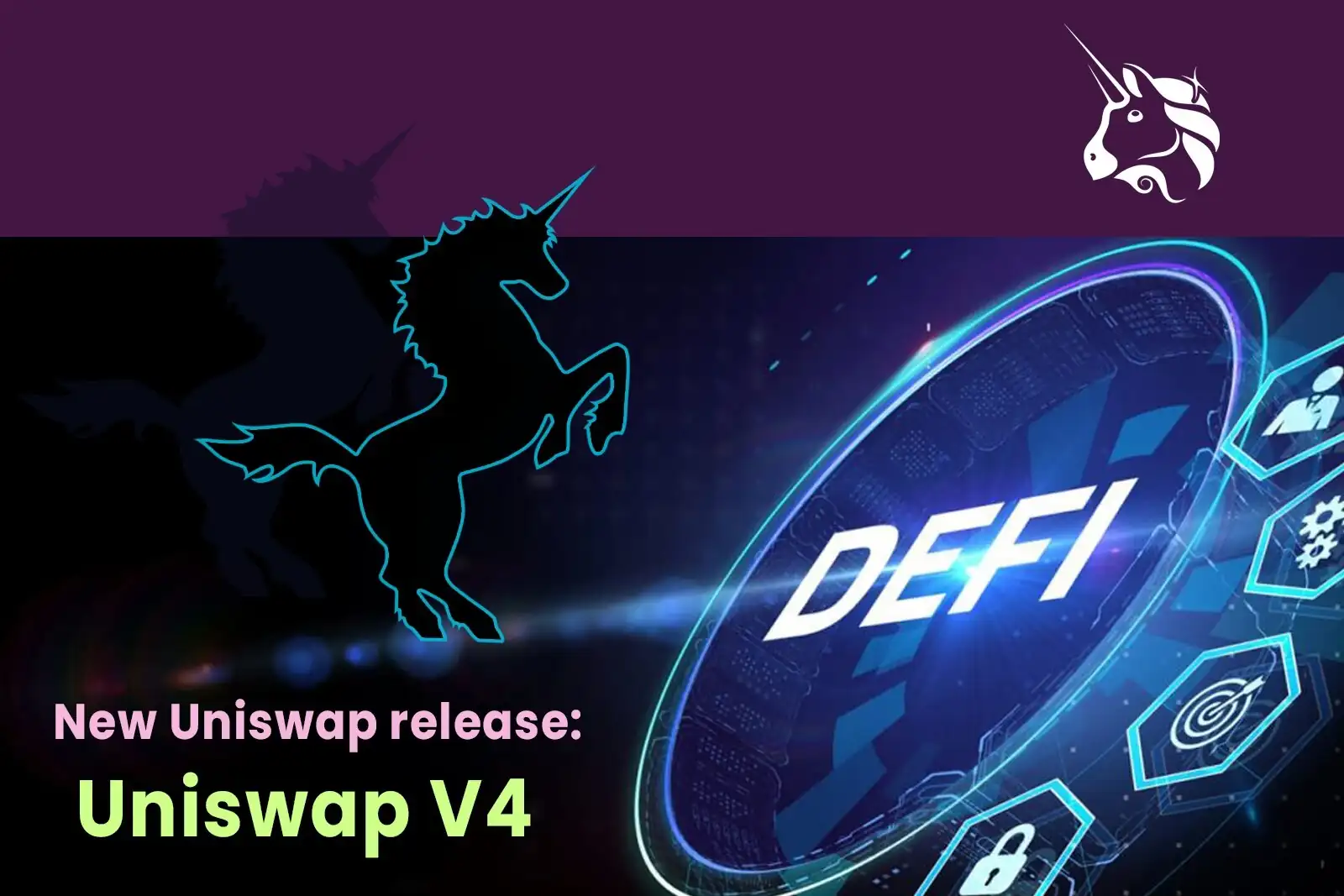Introduction
In decentralized finance (DeFi), Uniswap has emerged as a leading decentralized exchange (DEX) protocol. Built on the Ethereum blockchain, Uniswap has revolutionized how users trade cryptocurrencies and provide liquidity. In this article, we will explore the fundamentals of Uniswap and delve into the exciting features and advancements offered by Uniswap v4.
What is DeFi?
DeFi, short for Decentralized Finance, refers to a financial system built on blockchain to provide open, permissionless, and decentralized alternatives to traditional financial intermediaries and services. DeFi platforms utilize intelligent, self-executing contracts with predefined rules and conditions to automate and facilitate various financial transactions and services without intermediaries like banks or financial institutions. DeFi encompasses various applications and services, including lending and borrowing platforms, decentralized exchanges (DEXs), stablecoins, yield farming, decentralized insurance, asset management, and more. These platforms typically operate on public blockchains, most notably Ethereum, but other blockchain platforms are also emerging to support DeFi applications. Critical characteristics of DeFi include:
● Openness: DeFi platforms are accessible to anyone with an internet connection and do not impose strict eligibility criteria or require permission to participate.
● Transparency: DeFi transactions and operations are recorded on public blockchains, allowing anyone to view and verify them in real time.
● Security: DeFi relies on the security features of blockchain technology, including cryptographic encryption and immutability, to ensure the integrity and safety of financial transactions.
● Interoperability: DeFi protocols can interact and integrate, allowing composability and creating more complex financial applications.
● Financial Inclusion: DeFi aims to provide financial services to individuals who may be unbanked or underserved by traditional financial institutions, enabling them to access various financial products and services.
While DeFi has gained significant popularity and shown promising potential, it's important to note that it operates in a relatively new and rapidly evolving landscape. The DeFi ecosystem also carries risks, including smart contract vulnerabilities, price volatility, and regulatory uncertainties. Therefore, users should exercise caution, conduct thorough research, and understand the risks associated with each DeFi platform or service before participating.
What is Uniswap?
Uniswap is a decentralized exchange protocol that enables users to trade ERC-20 tokens directly from their wallets, like PlasBit wallets, without intermediaries or traditional order books. It utilizes automated market making (AMM), where individuals rather than centralized institutions provide liquidity. Uniswap operates on the principle of smart contracts, allowing users to exchange tokens trustless and permissionless.
The key features and characteristics of Uniswap include:
● Automated Market Making (AMM): Uniswap uses an AMM model, which relies on liquidity pools rather than traditional order books. Liquidity providers lock their tokens into these pools, allowing users to trade against them. The automated pricing algorithm adjusts the token price based on the ratio of available tickets in the collection.
● Decentralization: Uniswap operates decentralized, relying on smart contracts and the Ethereum network. There is no centralized authority controlling or governing the protocol. Anyone can access and use Uniswap by connecting their Ethereum wallet to the platform.
● Token Swaps: Users can trade between various ERC-20 tokens supported by the Uniswap protocol. The platform allows for direct token-to-token swaps without the need for a native platform token.
● Liquidity Provision: Users can become liquidity providers by depositing an equal value of two tokens into a liquidity pool. In return, they receive liquidity provider (LP) tokens representing their share in the collection. Liquidity providers earn trading fees and can withdraw their funds at any time, along with their proportional share of the costs accumulated.
● Governance: Uniswap introduced a governance token called UNI. Holders of UNI tokens have voting rights to propose and decide on protocol upgrades, fee structures, and other governance-related matters.
Uniswap gained significant popularity for its ease of use, open access, and decentralized nature. It has enabled decentralized token trading and fostered liquidity in the DeFi ecosystem. However, it's important to note that Uniswap, like other DeFi protocols, carries risks such as impermanent loss and potential vulnerabilities in smart contracts. Users should exercise caution and research before engaging with Uniswap or any other decentralized exchange.

The Evolution of Uniswap
Uniswap Version 1
Uniswap Version 1, launched in 2018, introduced the concept of decentralized exchanges powered by liquidity pools. Users could create collections by depositing equal values of two different ERC-20 tokens, and these pools would determine the token swap rates based on an automated algorithm.
Uniswap Version 2
Uniswap Version 2, released in 2020, built upon the success of its predecessor by introducing new features and improvements. Notable enhancements included:
● Flash swaps.
● Enabling users to borrow tokens without collateral.
● Creating pools with ERC-20 tickets with different values.
Uniswap Version 3
Uniswap Version 3, launched in 2021, introduced concentrated liquidity, allowing liquidity providers to allocate their funds within a specific price range, thus optimizing capital efficiency. This update brought improvements in terms of slippage and capital utilization.
Uniswap Version 4
Uniswap version 4 (Uniswap V4) introduces exciting improvements to enhance the efficiency and cost-effectiveness of the protocol. One significant change is implementing a singleton contract that holds all the liquidity pools together. This consolidation eliminates transferring tokens between contracts, resulting in substantial gas savings. Initial estimates indicate that a staggering 99% reduces the gas costs for creating collections. The singleton architecture streamlines the routing process across various options, providing a world of possibilities. Uniswap V4 adopts a new "flash accounting" mechanism to optimize the system further. Unlike in the previous version, where assets were transferred in and out of pools after each swap, the new system only moves the net balances. This approach significantly improves efficiency and leads to additional gas savings. The adoption of "transient storage" through the proposed Ethereum Improvement Proposal (EIP-1153) is an essential part of the flash accounting design. If implemented in the Ethereum Cancun hard fork, this EIP will bring even more substantial gas improvements and cleaner contract designs across various applications. With the efficiency of the singleton architecture and flash accounting system, Uniswap V4 offers increased flexibility in setting fee tiers. Pool creators can choose the level that makes them most competitive or customize them dynamically using a fee hook. Additionally, Uniswap V4 reintroduces support for native ETH, unlocking additional gas savings. These enhancements in Uniswap V4 pave the way for more efficient and cost-effective decentralized trading and liquidity provision. By reducing gas costs and introducing innovative mechanisms, Uniswap continues to advance the possibilities of decentralized finance, benefiting users and developers alike.
Understanding Uniswap Version 4
Enhanced Liquidity and Capital Efficiency
Uniswap v4 introduces liquidity and capital efficiency improvements using multiple fee tiers and concentrated liquidity ranges. This enables liquidity providers to allocate their funds more precisely, reducing capital wastage and increasing returns.
Concentrated Liquidity Pools
V4 introduces exciting advancements that empower users with customizable liquidity through "hooks." These hooks serve as plugins, enabling users to create bespoke liquidity pools and exert control over the interactions between pools, swaps, and fees. Developers can leverage these hooks to implement a wide range of functionalities. For example, they can incorporate on-chain limit orders, dynamic fee structures, and various automated functions that can be executed at specific times during a pool's lifespan. This flexibility opens up new possibilities for tailored and automated trading experiences. Additionally, Uniswap V4 brings an architectural improvement by consolidating all pools into a single smart contract. In the previous version, V3, a new contract had to be deployed for each collection created. With the unique architecture of V4, this consolidation significantly reduces the gas costs associated with creating pools, estimating a remarkable 99% reduction. These enhancements in Uniswap V4 provide users and developers with greater control and customization options, ultimately improving the liquidity provisioning process. By enabling customizable liquidity and streamlining pool creation, Uniswap continues to advance the capabilities of decentralized finance, fostering innovation and empowering users in the ever-evolving DeFi landscape.
Single-Sided Liquidity Provision
Uniswap v4 introduces a single-sided liquidity provision, which means users can provide liquidity with only one token instead of a pair. This eliminates the need to hold equal amounts of two passes, making it easier for users to participate in liquidity provision.
Oracle Flexibility
Uniswap v4 offers enhanced Oracle flexibility, allowing developers to integrate various price feeds and oracles into their applications. This feature ensures accurate and reliable price information for efficient token swaps and other DeFi operations.
Improved User Experience
Uniswap v4 has a more intuitive and user-friendly interface, making navigating the platform easier for novice and experienced users. The improved design and user experience contribute to a seamless trading and liquidity provision process.
Benefits of Uniswap V4
Lower Fees and Slippage
Uniswap v4 implements a novel fee tier system to reduce trading fees and slippage. By aligning costs with actual liquidity utilization, users can enjoy more cost-effective trades, making Uniswap a more attractive option for traders of all sizes.
Optimized Capital Allocation
With concentrated liquidity pools and single-sided liquidity provisions, Uniswap v4 allows liquidity providers to maximize their capital allocation. This feature enables more efficient use of funds and potentially higher returns on liquidity provision.
Simplified User Interface
Uniswap v4 introduces an improved user interface, enhancing the user experience. The intuitive design and simplified processes make it easier for users to navigate the platform, thereby attracting a broader user base.
How to Use Uniswap Version 4
Connecting Your Wallet
To use Uniswap v4, connect your compatible Ethereum wallet, and the Uniswap interface will allow you to interact with the protocol securely.
Selecting a Token Pair
Once your PlasBit wallet is connected, select the desired token pair you wish to trade or provide liquidity for. Uniswap v4 offers a wide range of token options, allowing you to explore various trading opportunities.
Swapping Tokens
If you want to swap tokens, specify the token you wish to trade and the token you want to receive. Uniswap v4 will display the estimated rate, including fees and slippage. Confirm the transaction and approve the token swap to complete the trade.
Providing Liquidity
To provide liquidity, select the desired token pair and specify the amount of each token you wish to contribute. Uniswap v4 will calculate your proportional share of the liquidity pool, and in return, you will receive liquidity tokens representing your stake. These tokens can redeem your share of the collection at any time.
Limitations of Uniswap Version 4
Impermanent Loss
Liquidity providers on Uniswap face the risk of impermanent loss, which occurs when the value of the deposited tokens diverges from the market price. While Uniswap v4 reduces this risk through concentrated liquidity pools, knowing the potential impact on returns is essential.
High Gas Fees
Due to its operation on the Ethereum blockchain, Uniswap transactions are subject to gas fees. During periods of network congestion, these fees can be substantial, affecting the overall cost-effectiveness of trades and liquidity provision.
Centralized Token Listings
Uniswap relies on external sources for token listings, which means that not all tokens are immediately available for trading on the platform. Token availability depends on external integrations and token listings, which can introduce centralization concerns.
The Future of Uniswap
As the DeFi ecosystem continues to evolve, Uniswap v4 remains at the forefront of innovation. The team behind Uniswap is actively working on further improvements and upgrades to enhance the protocol's scalability, security, and user experience. With each new version, Uniswap strives to unlock the full potential of decentralized exchanges and empower users with digital assets.
Conclusion
Uniswap has revolutionized decentralized exchanges, providing users with a seamless and trustless platform for trading and liquidity provision. With the release of Uniswap v4, the protocol introduces exciting features like enhanced liquidity, concentrated liquidity pools, and single-sided liquidity provision. These advancements contribute to a more efficient and user-friendly experience, making Uniswap a compelling choice for DeFi enthusiasts. Embrace the power of Uniswap v4 and unlock the full potential of decentralized finance.







